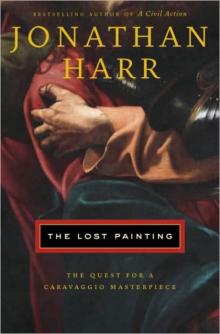Read The Lost Painting Storyline:
Amazon.com ReviewIn 1992 a young art student uncovered a clue in an obscure Italian archive that led to the discovery of Caravaggio's original The Taking of the Christ, a painting that had been presumed lost for over 200 years. How this clue--a single entry in an old listing of family possessions--led to a residence in Ireland and the subsequent restoration of this Italian Baroque masterpiece is the subject of this brisk and enthralling detective story. The Lost Painting reads more like a historical novel than art history, as Harr smoothly weaves several narratives together to bring the story alive. Though he does not provide an in-depth examination of the painting itself--the book is not aimed specifically at art experts--Harr does include many details for lay readers about restoration, the various methods used to track artwork through history, how originals are distinguished from copies, and an inside view of the art world, past and present. He also discusses various forensic approaches, including X ray, infrared reflectography, chemical analysis of the paints and canvas, and other modern techniques. But most of the book is focused on more primitive methods, including dogged research through dusty archives and meticulous attention to detail. This entertaining book boasts an engaging cast of characters, all of whom are inflicted with the "Caravaggio disease," including some of the foremost Caravaggio scholars in the world, persistent students, obsessive restorers, and most of all, the artist himself. Mercurial, supremely gifted, and prone to violence, Caravaggio lived like an outlaw and a pauper most of his troubled life. Yet even when he attained wealth and fame--and briefly, respectability--he was still hounded by the law (for murder) and numerous vengeful enemies. Harr does an admirable job of bringing the man alive in these pages while keeping his long-lost painting at the center of the action. --_Shawn Carkonen_From Publishers WeeklyGiven the relative obscurity of 16th-century the Italian baroque master and all-around creative bad boy Michelangelo Merisi da Caravaggio, who after a flare of fame remained relatively unknown from his death until the 1950s, the 1992 discovery of the artist's missing painting The Taking of Christ understandably stirred up a frenzy in academic circles. Harr's skillful and long-awaited follow-up to 1997's A Civil Action provides a finely detailed account of the fuss. While contoured brush strokes and pentimenti repaints have little to do with the toxic waters and legalese Harr dissected in his debut, the author writes comfortably about complex artistic processes and enlivens the potentially tedious details of artistic restoration with his lively and articulate prose. Broken into short, succinct chapters, the narrative unfolds at a brisk pace, skipping quickly from the perspective of 91-year-old Caravaggio scholar Sir Denis Mahon to that of young, enterprising Francesca Cappelletti, a graduate student at the University of Rome researching the disappearance of The Taking of Christ. The mystery ends with Sergio Benedetti, a restorer at the National Gallery of Ireland, who ultimately discovers the lost, grime-covered masterpiece in a house owned by Jesuit priests. But while adept at coordinating dates and analyzing hairline fractures in aged paint, Harr often seems overly concerned with the step-by-step process of tracking down The Taking of the Christ, as if the specific artist who created it were irrelevant. Granted, Harr is not an art historian, but his lack of artistic analysis of Caravaggio's paintings may frustrate readers who wish to know more about the naturalistic Italian's works. (Nov. 1) Copyright © Reed Business Information, a division of Reed Elsevier Inc. All rights reserved.Pages of The Lost Painting :
